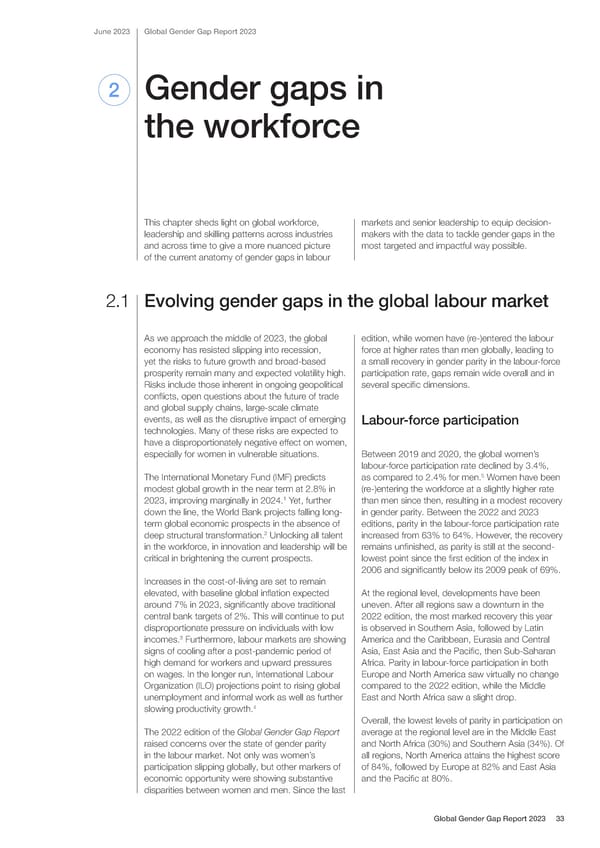June 2023 Global Gender Gap Report 2023 2 Gender gaps in the workforce This chapter sheds light on global workforce, markets and senior leadership to equip decision- leadership and skilling patterns across industries makers with the data to tackle gender gaps in the and across time to give a more nuanced picture most targeted and impactful way possible. of the current anatomy of gender gaps in labour 2.1 Evolving gender gaps in the global labour market As we approach the middle of 2023, the global edition, while women have (re-)entered the labour economy has resisted slipping into recession, force at higher rates than men globally, leading to yet the risks to future growth and broad-based a small recovery in gender parity in the labour-force prosperity remain many and expected volatility high. participation rate, gaps remain wide overall and in Risks include those inherent in ongoing geopolitical several speci昀椀c dimensions. con昀氀icts, open questions about the future of trade and global supply chains, large-scale climate events, as well as the disruptive impact of emerging Labour-force participation technologies. Many of these risks are expected to have a disproportionately negative effect on women, especially for women in vulnerable situations. Between 2019 and 2020, the global women’s labour-force participation rate declined by 3.4%, 5 The International Monetary Fund (IMF) predicts as compared to 2.4% for men. Women have been modest global growth in the near term at 2.8% in (re-)entering the workforce at a slightly higher rate 1 2023, improving marginally in 2024. Yet, further than men since then, resulting in a modest recovery down the line, the World Bank projects falling long- in gender parity. Between the 2022 and 2023 term global economic prospects in the absence of editions, parity in the labour-force participation rate 2 deep structural transformation. Unlocking all talent increased from 63% to 64%. However, the recovery in the workforce, in innovation and leadership will be remains un昀椀nished, as parity is still at the second- critical in brightening the current prospects. lowest point since the 昀椀rst edition of the index in 2006 and signi昀椀cantly below its 2009 peak of 69%. Increases in the cost-of-living are set to remain elevated, with baseline global in昀氀ation expected At the regional level, developments have been around 7% in 2023, signi昀椀cantly above traditional uneven. After all regions saw a downturn in the central bank targets of 2%. This will continue to put 2022 edition, the most marked recovery this year disproportionate pressure on individuals with low is observed in Southern Asia, followed by Latin 3 incomes. Furthermore, labour markets are showing America and the Caribbean, Eurasia and Central signs of cooling after a post-pandemic period of Asia, East Asia and the Paci昀椀c, then Sub-Saharan high demand for workers and upward pressures Africa. Parity in labour-force participation in both on wages. In the longer run, International Labour Europe and North America saw virtually no change Organization (ILO) projections point to rising global compared to the 2022 edition, while the Middle unemployment and informal work as well as further East and North Africa saw a slight drop. slowing productivity growth.4 Overall, the lowest levels of parity in participation on The 2022 edition of the Global Gender Gap Report average at the regional level are in the Middle East raised concerns over the state of gender parity and North Africa (30%) and Southern Asia (34%). Of in the labour market. Not only was women’s all regions, North America attains the highest score participation slipping globally, but other markers of of 84%, followed by Europe at 82% and East Asia economic opportunity were showing substantive and the Paci昀椀c at 80%. disparities between women and men. Since the last Global Gender Gap Report 2023 33
 Global Gender Gap Report 2023 Page 32 Page 34
Global Gender Gap Report 2023 Page 32 Page 34